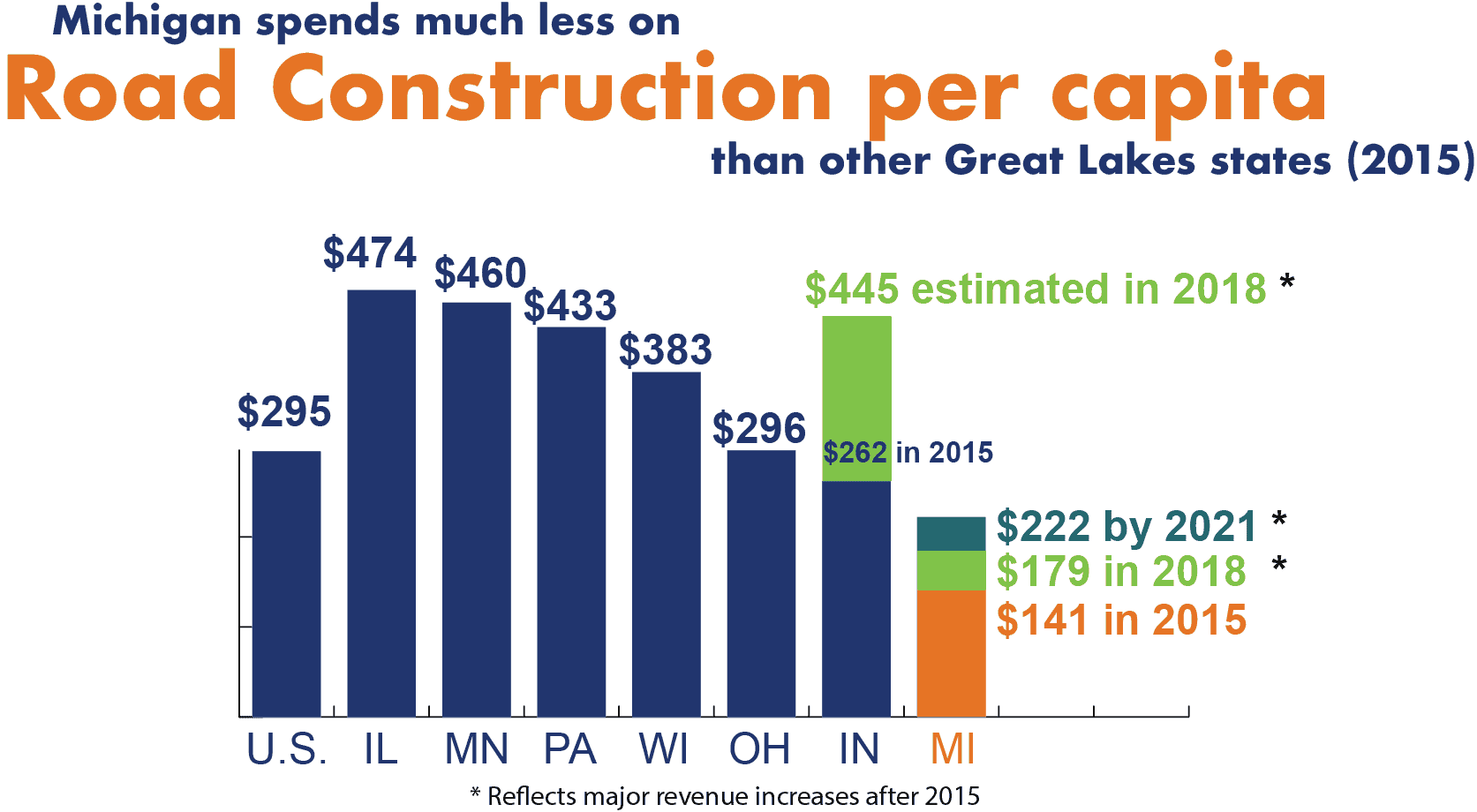In the latest issue of Semscope you will find an article that outlines some issues related to Michigan’s history on road funding.
When someone asks why Michigan’s roads are in such bad shape, especially as compared to the roads in some of our neighboring states, you will probably receive answers that run the gamut of reasoning. Many will try to tag the road departments as the culprit – government just can’t do the job right. Others might blame private contractors for doing shoddy work. While there are enough anecdotal stories to generate a lively discussion, none of the stories are unique to our state, so what is the big difference between Michigan and the rest of the nation?
U.S. Census information provides some very eye-opening insight as to what has been happening to Michigan’s roads. Each year, local governments fill out F-65 reports that detail their revenues and expenditures. Those reports eventually make their way to the U.S. Census, which issues a yearly report on state and local revenue and expenditures. Once every five years they also release a report that breaks down local government revenue and expenditures by type of government. The latest census report details finances from 2015. The 2016 report should be released this fall.
When looking at total expenditures for roads in 2015, Michigan spent $370 per person. That figure was last in the nation. Nationally, state and local governments were spending an average of $536 per person on roads. Some may argue that it might be improper to compare Michigan’s expenditures to Vermont or Montana because of geography or population differences. However, comparing Michigan to our neighboring states, all with similar size, populations, and maybe, more importantly, weather conditions indicates an even bigger funding gap. Illinois, Indiana, Minnesota, Ohio, Pennsylvania, and Wisconsin averaged $660 per person on road expenditures, again as compared to Michigan’s $370 in 2015.
If this were a onetime occurrence, it might not be an issue. Unfortunately, this is the pattern that has existed for a quarter of a century. Michigan has consistently been ranked near the bottom of the list when looking at per capita expenditures for roads dating back to 1992. The gap between Michigan and the rest of the nation has been widening on a yearly basis.
The Census information also allows us to examine road expenditures from two perspectives – maintenance/operations expenditures verses capital outlay/construction expenditures. Over the past 25 years, roughly the typical useful life of a paved road, Michigan has traditionally ranked dead last in the nation in per capita expenditures for capital outlay. Michigan has been spending about half of the national average on road construction over that time frame. In 2015, Michigan’s per capita expenditures for road construction were about a third of the rest of the Great Lakes region.

On the flip side, Michigan’s expenditures for operations and maintenance have been much closer or even greater than the national average. While being at the national average for operational costs may sound reasonable, it must be noted that Michigan has above average needs. The simple fact that Michigan is a cold weather state that must put significant resources into plowing and salting makes it more costly to maintain the roads, as compared to many other states. Add into the equation that poor roads need extra attention for pothole filling and other band-aid services just to make the roads passable again increases operational costs. Comparing Michigan to its neighboring states, we are spending about 85% of what other Great Lakes states are spending on operations and maintenance.
Did the 2015 legislative changes dig us out of the (pot)hole?
In 2015, the State Legislature passed legislation that increased fuel taxes and registration fees beginning January 1, 2017. The legislation also dedicates a portion of state income taxes to be shifted into the transportation fund over three years beginning on October 1. The legislation increases our transportation funding on a permanent basis by $1.2 billion per year when it is fully implemented in 2021. However, the proposal also eliminated $400 million in temporary funding that was being added to the transportation budget in 2015. This money will result in many more road projects being accomplished, but it will still leave Michigan well short of what other states are spending on roads.
If all of the new revenues go into road construction, Michigan will move from 50th in the nation in to 40th in 2021. This assumes that other states don’t react to what is considered a national priority with their own revenue increase. Indiana has already increased its road revenues by $1.2 billion per year since Michigan passed its road package. Indiana has two-thirds of Michigan’s population. Michigan will continue to be tackling a huge backlog of road projects with below-average funding levels.
While half a loaf is better than none…it is still half a loaf.

Leave a Reply